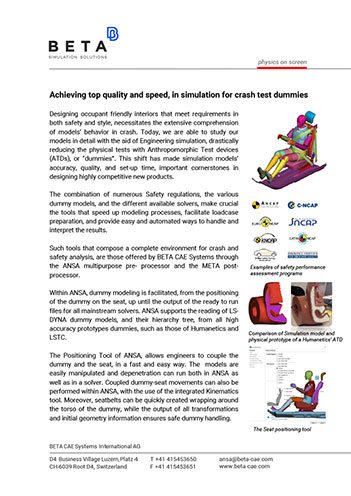ANSYS Version 19.2 Released
Pre-processing and Meshing News
Pre-processing and Meshing Resources

Latest News
September 18, 2018
ANSYS 19.2, ANSYS' latest release, features fluids meshing technology to improved workflows for safety analysis to a system coupling engine.
This latest release of ANSYS Pervasive Engineering Simulation solutions empowers users to accelerate the design process with its new single window, efficient workflows and advanced meshing technology for computational fluid dynamics (CFD). There are new processes for developing embedded software for safety-critical applications, computational speed and user experience improvements for solving automotive radar scenarios, digital twins, 3D design exploration and structural modeling.
Highlights
In the fluids suite, ANSYS 19.2 delivers new features to accelerate CFD simulations to boost productivity. The task-based workflow for watertight geometries supports Mosaic meshing technology. ANSYS Fluent meshing now includes a fully automated, technology. This Mosaic technology automatically combines a variety of boundary layer meshes using polyhedral meshes for accurate flow resolution for fewer, better quality cells.
ANSYS 19.2 introduces System Coupling 2.0 for multiphysics simulation. System Coupling 2.0 offers improved and consistent performance for any scenario and is fully validated against the original version of the engine. Users can take advantage of the high-performance computing (HPC) resources for multiphysics simulations and quickly map data.
Engineers will benefit from the new functionality to improve workflow and speed up the development process for semiconductor manufacturers, specifically those used in the automotive and autonomous vehicle industries with dedicated ISO 26262 support to meet safety regulations, through the newly released medini analyze for semiconductors solutions.
The ANSYS systems suite has new features and functionalities focused on the development of digital twins, autonomous and electric vehicles. New capabilities make it easier and faster to build, validate and deploy digital twins. Now users can visualize 3D fields of static ROMs and view simulation results, like velocity and flow rate, on the 3D geometry.
ANSYS is introducing ANSYS VRXPERIENCE, which enables users to fully and realistically simulate autonomous vehicles using real-world conditions, including various weather and road conditions, oncoming vehicles, pedestrian scenarios and anticipating the vehicle’s reaction to any critical situation.
In the embedded software suite, new capabilities will make it easier and faster for engineers to design their embedded system architecture and develop and verify safety-critical embedded code. ANSYS SCADE Suite has improvements to both the design verifier and the Simulink importer. ANSYS SCADE LifeCycle now offers Jama from Jama Software to ANSYS’ supported requirements manageability tools.
ANSYS 19.2 also introduces a product bundle, ANSYS SPEOS, a complete solution for designing and simulating illumination, interior and exterior lighting, cameras and LiDARs and optical performance. Now, designers can uniquely simulate optical performance within a system and evaluate and test the final illumination effect.
The Discovery family of products has been enhanced to simplify and streamline 3D simulation. ANSYS Discovery Live now includes a parameter studies capability, scripting and customization features.
ANSYS 19.2 delivers advanced capabilities in the structural suite. New enhanced inverse analysis, material designer and topology optimization developments give engineers more simulation options. New hot to cold, or inverse, analysis enables engineers to calculate the cold, or unloaded, the shape of a component to achieve the desired hot shape and performance during operation.
ANSYS19.2 additive solutions provide improved robustness for both ANSYS Additive Print and ANSYS Workbench Additive. Additive Suite now includes physics-driven lattice optimization.
New advancements in multi-channel radar system simulation include lightweight geometry modeler that enables rapid meshing and efficient actor movement in pulse-by-pulse road scene simulation. ANSYS Icepak adds the ability to compute thermal impact from multiple electromagnetic loss connections.
Sources: Press materials received from the company.
More Ansys Coverage
For More Info
Subscribe to our FREE magazine, FREE email newsletters or both!
Latest News
About the Author
DE’s editors contribute news and new product announcements to Digital Engineering.
Press releases may be sent to them via [email protected].




